When we lived in Hoi An Vietnam, we started to discover workshops and small factories “off the beaten path”, dedicated to local crafts, dried fish and boat repair.
The rustic, visually interesting workshops were teaming with activity, and always delivered a memorable dimension to our discovery of our host country. (I call this “industrial tourism”, even though these are not set up or organized this way, but rather are the result of our curiosity and local hospitality. As I have worked in manufacturing in the aerospace and defense field in the past, I am always fascinated by industrial process and the making of stuff.)
Today, I am taking Peta on an “industrial date”. Let’s see what we discover…
We’ve driven our motor scooter past these gates many times before, near where I buy newspapers, at a little street side store. The large sign “Haileys” tells us this factory is part of the Haileys group, one of the largest conglomerates in Sri Lanka. Amongst other many industrial achievements, Haileys has become one of the world’s largest producers of coconut shell activated carbon, at a different location, which has a large range of applications (http://www.haycarb.com/).
This coconut shell carbon company accounts for over 16% of the global market share. The company has an annual capacity of over 42,000 metric tons of activated carbon. They manufacture a complete range of coconut shell derived, activated carbon for a full spectrum of applications in water treatment, air quality filters, food and beverage Industry, and energy storage. So basically a very eco friendly product.
However, the coconut shells are covered with a husk or fibre. What to do with all this husk and fibre, so as not to waste this material, but rather find productive uses for it?
Haileys have developed an entire market using the coconut fibers (http://www.hayleysfibre.com/). We are interested to find out what range of applications there are for this “coir fibre”. Will they give us an impromptu “tour”, or will we just be able to take a peek?
Let’s go in and find out…
We are warmly welcomed to look around, and the general manager is called to give us a look/see.
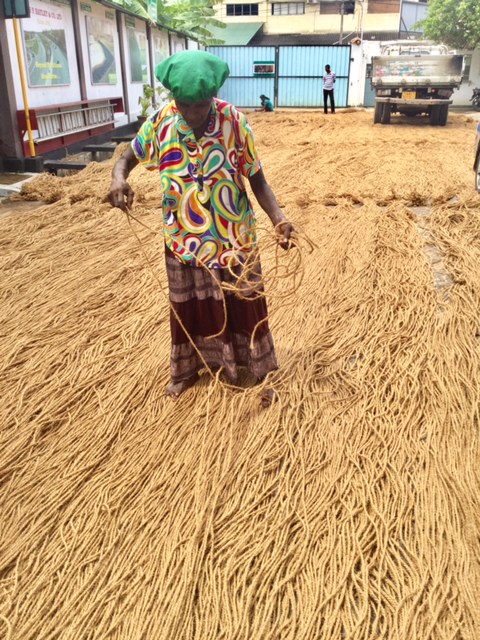
Behind the pale blue steel gates of the factory, we come upon a sea of cashew colored rope paving the grounds, like a textured wall to wall carpet. This is going to be fun!
Rope making with coconut coir is of course nothing new in Sri Lanka. It has been a traditional craft for centuries. Everyone uses coconut husk string and rope for everything. It is sold in all the little hardware shops and the small mom and pop veggie stands.
Here is a short video to see what a traditional rural set up and processing looks like:
“Haileys Fibre” business takes this traditional craft to a whole new level. This is what the intersection of traditional craft and industrialization looks like, on the coast of Southern Sri Lanka.

It all starts with the raw coconut husk fiber, so called “coir.” The large warehouse at the beginning of the process holds mounds of fibre piled high. Quite a sight.
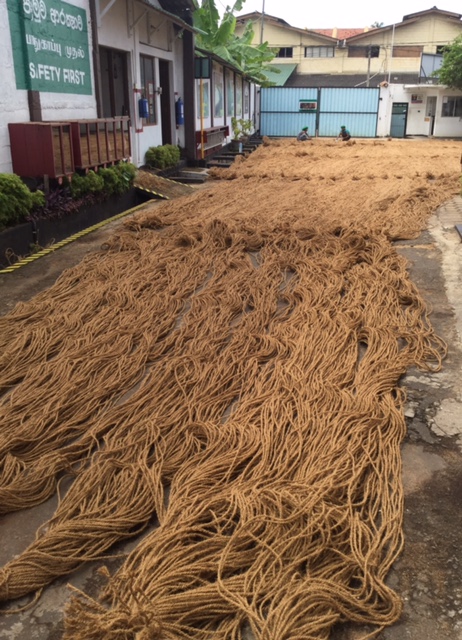
The strands of rope are tied into bundles of equal lengths and size. This is easiest done by laying all the rope out on the ground.

In another part of the factory, the rope is spun from fibre and then these guides are used to create the bundles. There are in total about 200 workers at this factory.

The long bundles of rope are twisted into a large diameter braid rope. Watching the men twisting these huge rope bundles is mesmerizing, as they go through their well practiced synchronized movements.
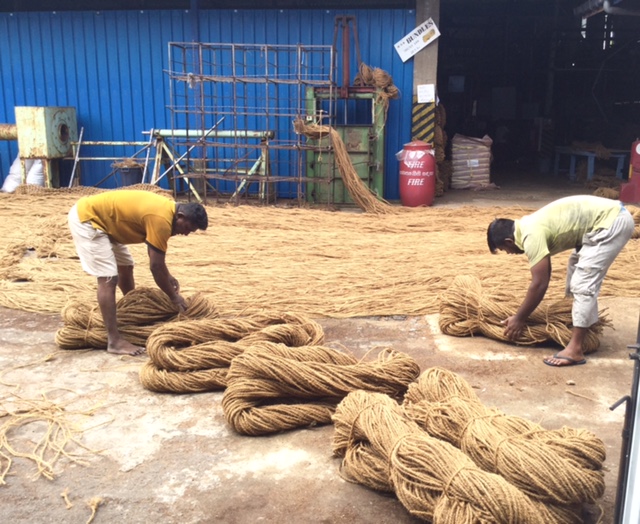 Once the ropes are strung out, tied, they then get folded into individual bundles. Looking like giant size textured yarn skeins.
Once the ropes are strung out, tied, they then get folded into individual bundles. Looking like giant size textured yarn skeins.
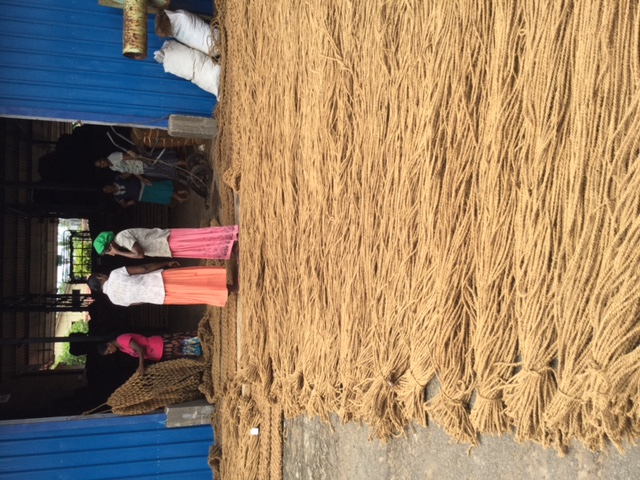
Men and women are employed here. An unusual balance of gender in an industrial sector which tends to be male oriented.
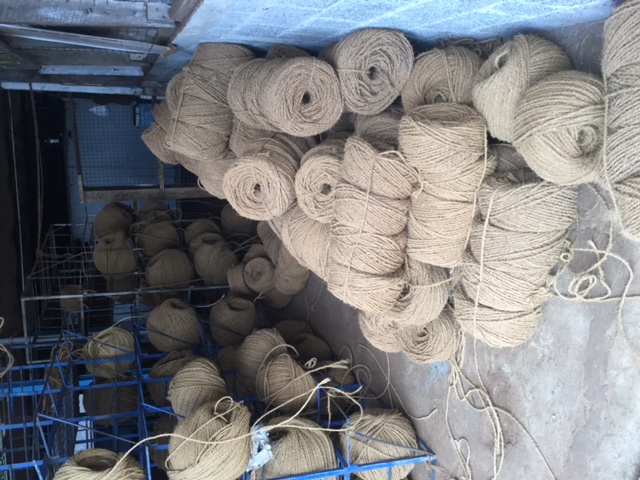
Another product is a coarse string, or thinner rope which is formed into a heavy and tightly wound ball.

On the left, yet another product – the fibre gets woven into macrame like nets. Not sure yet what this is used for..

Every ground surface is used for various stages of the process. Rows of strung out rope, bundled rope and woven rope netting.

This tubular woven product looks like giant long scratchy hair nets. It turns out to be the casing for a totally surprising product. The netted woven casing is used for erosion control on river banks, hillsides, anywhere that soil is being eroded by the elements. This product is exported to the U.S.
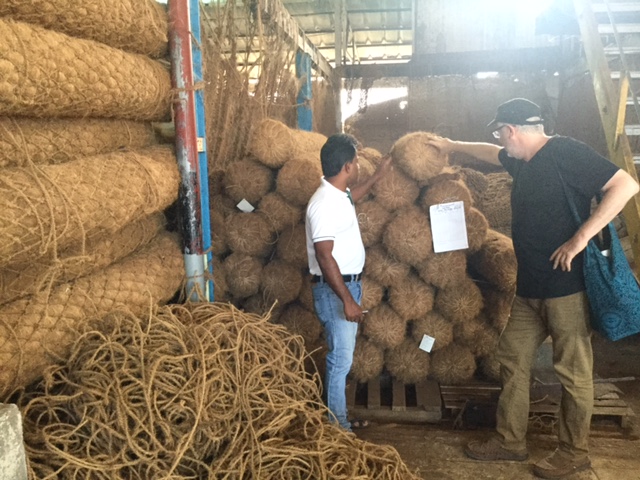
I am fascinated by the Climate Adaptation potential of these river embankment and erosion control “mats”. The manager is a welcoming impromptu host and takes a few minutes to walk us through his process and answer questions, of which we have many.

Long giant sausage like tubes are piled up, all ready for export. A natural eco friendly material for climate adaptation solutions.

Who knew that the humble coconut husk and its fiber could be a solution for climate adaptation and soil erosion?
Here is an example of one of the “off the beaten track” visits to a factory fish drying factory:
http://www.greenglobaltrek.org/2013/09/adventures-off-the-beaten-path-hoi-an-dry-fish-and-bamboo-boats.html
Great post Ben. I love this kind of thing. It reminded me of visiting a rice noodle factory in Vietnam.
Thanks Alison. Yes, exactly. These Asian production facilities are always very interesting. The equipment is often low tech but productivity is usually high and there is always much going on. We always look for these kind of opportunities. India offered a really interested fabric printing facility that we visited many years back, before we launched our blog. It was so memorable, we often still talk about it.
Ben
Ben
The husks remind me of my messy, straw-like hair. Enjoyed the post anyway. 🙂
Sounds like you are ready for dreadlocks Peggy! 🙂
Ben
I’ve been following and enjoying your posts Ben and Peta.
What a wonderful adventure and experience you are having. Your curiosity, openness, appreciation for differences and joy in the simple things is lovely. Thank you for taking me on this journey with you both. Life is just a bunch of coconuts. :-).
Welcome to our Green Global Trek Julie. Thank you for the compliments. It is the combination of curiosity and openness (or lack of fear) in cross cultural situations that puts authentic experiences along our path.
About those coconuts: My day started with fresh coconut water, then I ground a coconut to make fresh coconut milk for my cappucino and we stepped outside onto the coconut husks spread across our garden to encourage ground cover growth. I swished some coconut oil in my mouth as an Ayurvedic practice for good oral and overall health. After my shower I used some coconut oil as a hair conditioner… and we ended the day with curry with fern shoots and coconut meat in it and coconut ice cream with passion fruit on it. Yes, “life is just a bunch of coconuts!”
Ben
How interesting and enterprising. Nice to see all parts of the coconut are being used.
Darlene one of the best things about this factory, in our opinion was not only the variety of products but the fact that there is zero waste of coconut material.
Ben
How fascinating! Had no idea there were even industries like this. And I have literally no idea how workers can stand to be around this stuff — seems as if particles would get into eyes and on skin. Makes me itchy just thinking about it. But I love woven rugs, etc. So maybe it’s the same. Thanks for sharing all of this.
Rusha, it is fascinating indeed that most Westerners have no conception of how stuff is manufactured. Most of the time we have some vague concept that there is some factory out there with some machine where somehow, whether it be apparel or toys or anything really, stuff magically comes together. In point of fact, Asia is a hotbed of workshops/factories where a wide range of products are pretty much hand produced. This is why I like visiting factories, when I inevitably conclude “oh THAT’s how that’s made!”
Ben
So fascinating! There’s always something new to learn through your posts.
Thanks Cheryl, that’s good to know… 🙂 Thanks for reading us and commenting.
Peta
Fascinating! Thanks for the tour.
Thanks Judith, glad you enjoyed it.
Ben
What a commendable way of using every last bit of a resource! Fascinating.
Anabel, it IS nice to see an industry that focuses so much on zero waste and has an environmentally friendly product. Glad you enjoyed this post.
Ben
Wonderful exploratory trip! This is an amazing post showing how so much rope is made by human hands at every step. The roosters crowing in the video add so much ambience to the video!
Thanks Aixa. It was a very fun process to watch and great to know that they have so many uses for all the different parts of the coconut. In fact, there is a shortage of coconuts in Sri Lanka, which we were surprised to hear, because they seem to be everywhere.
Usually we hear wild peacocks more than roosters!
Peta
So cool what can be done with coconut husks; I had no idea! Thanks for this fascinating post.
Thanks for the positive feedback Caroline. One never knows what appeals to others, but I particularly like these rustic industrial processes and glad to hear you do too. Much more is “made by hand” in Asia, than Westerners realize.
Ben
Having seen Peta’s instagram post I am so happy to see more of the fascinating process. Loved having the video of the women working together to do the weaving. Amazing how the large sausage looking bags are formed.
Sue, glad that the post on instagram brought you back to the blog. Thanks for stopping by and for your feedback.. The video is pretty cool. There was another part of the factory where the fibre is spun like these women do, but on an industrial scale with a whole lot of machines doing it.. This was the one part of the factory that they do not allow photographs to be taken. I always think about the geographic and cultural distance between the makers (in this case of the rope) and buyers at say Home Depot or Walmart in the U.S.
Ben
I’ve been an industrial process freak since I was a little kid and was taken to the Heinz factory in Pittsburgh. That’s very different from coconut husks, of course, but I love the ingenuity that is on display at these smaller, local factories, and I so appreciate the waste-not attitude they embody. I would have traipsed right in there behind you to marvel at those spaghetti strands of fiber!
Thanks Lex, it is nice to know you too appreciate industrial exploration. I was going to write about this being a form of industrial tourism in fact.. but then I remembered that if there are ever formal tours of almost anything I tend to run in the opposite direction 🙂 For example, here in Sri Lanka one can go on cinnamon processing tours, or tea production tours, but we have yet to do either of these.
Ben
Very intriguing, Ben. Your healthy curiosity leads you – and us – to interesting discoveries! I am a fan of using all the parts of a coconut (tree) or anything else that “dies”,, and it seems like this is certainly the case with coconuts (and coconut trees) in Sri Lanka and elsewhere the tropics!
Thanks Liesbet it is good to know that others find these industrial processes interesting to read. We used to find them very often in rural Viet Nam, where there are so many fish drying, rice noodle making and boat repair workshops. Those were our favorite places to visit.
Ben
I remember thinking, “I wonder where they got that?” when I read your post a few weeks ago and saw the shredded coconut husks you’d spread around your house for ground cover.
I too, find “the making of stuff” fascinating and totally enjoyed the video on making rope from coconut husk fibers as well as learning about the nets used for erosion control on river banks and hillsides.
Perhaps to the people who make these products it’s all in a day’s work, but to those of us who wonder about how things are made or the skills involved, it’s endlessly fascinating!
Anita, that is exactly how we discovered the coconut husk factory! A permaculture friend advised us to get bags of husks to spread on the ground to encourage the ground cover growth and it worked. Each large bag costs 60 rupees, which is 30c.
Nice to know there are so many of us out there who enjoy watching the process of “making stuff”…So far we have been pretty lucky with being allowed to go inside of the factories we have come across.. here but more so in Viet Nam, where every side little path had a workshop or factory of some sort.
Peta & Ben
What an incredibly resourceful process. Thanks a lot for sharing the details. 🙂 🙂
Thanks Johanna. It is nice to see processes that are resourceful and that do not create waste but instead use it for purposeful products.
Peta
I loved this post Ben. I am always fascinated by how resourceful some countries are. Sadly I don’t believe the US is one of them. I didn’t know that we imported our coconut husk rolls from Sri Lanka. There was a construction project going on at the ranch where we stayed in Yellowstone NP this past summer where these rolls were being used. During the bison rut, those big guys were taking out their aggression on these rolls, tossing them high in the air.
LuAnn ~ love the visuals of bisons getting their frustrations out on the coconut rope rolls. Do you have any photos of that happening? If so, it would be fun to share that with the factory; am sure they would enjoy seeing that. Happy to read that you enjoyed this post about resourcefulness. Who knew so many Green Global Trek readers would share our fascination with industrial processes? 🙂
Ben
I love that every part of the coconut is useful. What a wonderful industry, and seemingly environmentally friendly in every way. This gives me an even greater appreciation for the coconut, which I can’t imagine living without (how would I make my Brazilian fish stew without coconut milk?) 🙂
Laurel you make a very good point. We use coconuts for so much, especially here in Sri Lanka where they are readily available. Ben makes his fresh coconut milk every morning for his coffee, we use it in Sri Lankan curries, and the oil for just about everything (including as a skin moisturizer). Brazilian fish stew sounds yummy. I have a Brazilian daughter in law and I will have to ask her if she knows how to make that!
Peta
That’s amazing that you’re discovering such ‘offbeat’ units and sharing the story with us. The pictures make the visualization of the process so appealing! Coconut is very popular in South India.
We love to find places that are “off the beaten track” and have written many posts in different countries of places we find that are not main stream tourism destinations. Glad you enjoyed the process. Yes, coconuts are integral to cuisine in both India and Sri Lanka.
Ben
Omgosh,
Amazing.
I’m getting an entire education, darlings! x
Haha Kim, thanks. So glad you found this post interesting. It was an education for us too!
Peta
A fascinating look into an industrial process and such a great idea for exploring a region in more depth. You’ve inspired me to be on the lookout for interesting local factories in my travels.
Delighted to hear we have inspired you to be on the lookout for interesting off the beaten path ‘workshops’ and local factories. You will definitely be surprised once you start looking. For us, a visit to a local factory can be as illuminating and satisfying as a trip to a good museum.
Peta
That was a fascinating tour of an industry I’ve never thought about. Low tech, large application of something most people would regard as waste. With imagination and resolve. so much can be done to turn waste into useful products. Thanks for this insider’s view, Ben.
Shari this is the first time we have seen how the coconut industry operates per the principle of maximum usage of any and all material. Waste can be turned into useful products, but it can also be turned into energy as is being done in Europe. As they say, one mans garbage is another mans treasure.
Thanks for the comments.
Ben
What a fascinating world behind those industrial gates! Such a great use for something that would have been thrown away, too..
Yes. Today we just bought eight bags of the stuff and spread it out over our garden to encourage ground cover growth and improve the quality of the soil. There is a particular satisfaction, that comes from making use of something that would otherwise be discarded as waste. When you compare the statistics about the amount of waste generated by a North American, A European or a South Asian, it is mind boggling how much waste is generated in the West. Europeans manage to do something which North Americans have not managed to do, which is to almost entirely eliminate the amount of waste that goes into landfills. North Americans prefer to consume and discard liberally. And what does it require? Just building yet another monstrous landfill as opposed to European investment in “waste to energy” technology which allows for a much reduced amount of waste.
Ben
Hey, nice description, searching for some travel destination but landed on this page. You jotted down a perfect place to explore, sometimes such things provide better experience.
Thanks Kundan for stopping by Green Global Trek and taking the time to comment on our post. We do find that industrial “tourism” provides for some fascinating experiences in Asia. All it takes is knocking on the door and asking to look around… Sometimes it works, sometimes it doesn’t but it seems worth trying.
Ben